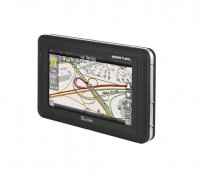
 TypeProcessorDisplayMemorySoftwareMaps, routes, tracksCommutationsAdditional functionsAutomobile navigators are already so firmly entrenched in our lives that it is unimaginable to imagine a journey, or simply moving around new towns and unfamiliar areas. Which navigator to choose? What aspects should be considered? This is our article. How do navigators work? In fact, this is a GPS receiver and a computer in one bottle. The receiver receives signals transmitted by satellites in orbit, and the computer decrypts the signal and determines the position of the receiver. Until recently, all household navigators worked on the American navigation system NAVSTAR (GPS). By the way, this system is so far the only fully functioning one. Belongs to NAVSTAR US Department of Defense. Satellites of the navigation system (there are 24 of them) are located in 6 planes at an altitude of approximately 20,180 km.
TypeProcessorDisplayMemorySoftwareMaps, routes, tracksCommutationsAdditional functionsAutomobile navigators are already so firmly entrenched in our lives that it is unimaginable to imagine a journey, or simply moving around new towns and unfamiliar areas. Which navigator to choose? What aspects should be considered? This is our article. How do navigators work? In fact, this is a GPS receiver and a computer in one bottle. The receiver receives signals transmitted by satellites in orbit, and the computer decrypts the signal and determines the position of the receiver. Until recently, all household navigators worked on the American navigation system NAVSTAR (GPS). By the way, this system is so far the only fully functioning one. Belongs to NAVSTAR US Department of Defense. Satellites of the navigation system (there are 24 of them) are located in 6 planes at an altitude of approximately 20,180 km.
 Recently, GLONASS, a system belonging to the Ministry of Defense of the Russian Federation, is redeploying its satellite constellation. GLONASS satellites (code “Hurricane”) are located in three planes at an altitude of approximately nineteen 100 km. Their nominal number is 24.
Recently, GLONASS, a system belonging to the Ministry of Defense of the Russian Federation, is redeploying its satellite constellation. GLONASS satellites (code “Hurricane”) are located in three planes at an altitude of approximately nineteen 100 km. Their nominal number is 24.
The European Galileo system, as well as the Chinese and Indian, is at the step of actively creating its own satellite constellations.
A type
There are a great many GPS navigators. Wrist, bicycle, motorcycle, aviation, marine, universal. We will focus on auto – devices with the ability to download maps, route calculation functions, also equipped with voice engines, telling the driver the routes in an unfamiliar city.
Independent GPS navigators do not need an external computer to work. They have their own display, which displays all the information about the user’s location. Such GPS navigators can be stationary or portable. The latter can be carried with you, they have capacious built-in batteries and have the ability to connect to the on-board 12-volt power supply. Car GPS navigators are stationary devices and are charged by the cigarette lighter.
Car GPS navigators are stationary devices and are charged by the cigarette lighter.
The design of the navigator is simple – a GPS receiver, processor, RAM, antenna, display, housing and battery. The speed of its operation depends on the power of the processor built into the navigator. This parameter is measured in a frequency indicator. In navigators, it ranges from two hundred sixty six to six hundred MHz. A device equipped with a powerful processor will quickly calculate the route, spend less time loading, etc. Processor The processor of a GPS navigator is a chipset, performs calculations to determine the coordinates and is responsible for receiving a signal. Now the most popular chip is SiRF Star III, SiRF Atlas III and SiRF Atlas IV and the latest development SiRF 3i + six hundred MHz. In the latest generation of navigators, a hardware graphics accelerator is added to the processor chip to display uncompressed video or “render” 3D building models in navigation programs.
Modern processors can apply WAAS / EGNOS corrections designed to increase coordinate accuracy, but only where there is a base station transmitting such corrections also have reduced power consumption. There are also Centrality Atlas III chipsets, which have been owned by SiRF for some time. Centrality Atlas processors are also popular with both navigation manufacturers and users. MTK chipsets have relatively low power consumption and support fifty-one channels that track satellites and use their signals to determine and update coordinates. However, they are significantly superior to the latest SiRF Star Atlas IV and SiRF 3i + designs supporting sixty-four parallel channels.
With an increase in the sensitivity of GPS receivers, in modern devices, the time spent by the GPS navigator on starts has significantly decreased.
